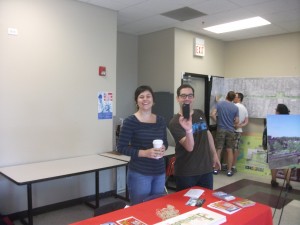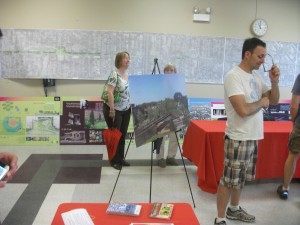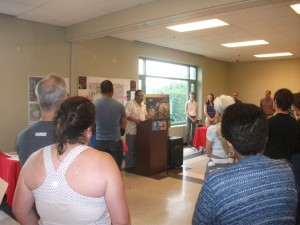Bridges come in many forms. There are 37 viaducts along the Bloomingdale Trail, the centerpiece of The 606 Project. It’s a northwest side Chicago project whose progress I have featured on this blog more than once in the past. Those viaducts are physical bridges that link the trail (and formerly the railroad) across underpasses that facilitate traffic below. More than a century ago, the city and the railroad agreed that elevating the spur line would alleviate traffic conflicts on the streets below.
Today the work on the trail also features more metaphorical bridges: those between people. Making the planning process and its implementation run more smoothly as the trail is constructed involves the judicious use of public-private partnerships, allowing both the public and private sectors to perform separate functions more efficiently and effectively. For that purpose, at the beginning of the project, the Chicago Park District hired the national organization, Trust for Public Land, as its representative in both organizing and managing public involvement in the project. The Trust for Public Land also helps manages the Park District’s relationships with the other city agencies involved, most notably the Chicago Department of Transportation (CDOT). CDOT is leading the construction because federal transportation enhancement funds provide the bulk of the funding for the $95 million project. As part of the public/private nature of the project, The Trust for Public Land is also leading the charge to raise money from private sources.
I took time recently to meet with Jamie Simone, who ten years ago worked for me as a research intern on an American Planning Association project on Planning for Wildfires. Jamie was enthusiastic and curious then, as she remains now that she is performing her dream job with The Trust for Public Land as program director for the Chicago Urban Parks Program. We discussed both what The Trust for Public Land actually does and how it does it.

Jamie, left, at a June 21, 2014, open house for the Bloomingdale Trail project at the Tribune-McCormick YMCA in Chicago.
The Trust for Public Land has a formal agreement with the Park District, Jamie noted, in which it serves as the district’s project coordinator and an “owner’s representative.” What this means in practical terms is that The Trust for Public Land provides an interface with other city agencies on behalf of the park district “to keep things moving forward.” What is important about this arrangement is that, for Jamie, this is her main project; for many of the people in city agencies, the park and trail system development is one of several projects among which they must divide their time. In short, The Trust for Public Land staff can give the trail a “different level of attention.” But, in addition, The Trust for Public Land can bring private fundraising to bear on the project, something inherently more difficult for the city itself to do.
Particularly in a big city like Chicago, however, the effective management of opportunities for citizen engagement with the project is critical. The failure to provide such opportunities has derailed more than a few big urban projects across the country over the years. People want to provide input, and when it comes to a project as intimately related to the quality of life in their neighborhoods as the Bloomingdale Trail, they want such input very much. Hundreds of neighborhood residents attended meetings over a period of months in the last two years that allowed them to see and comment on design options for not only the trail itself but the access ramps and their connections to nearby pocket parks and residential streets. I know that the input was real and sometimes fervent because I attended two of the bigger meetings. People had strong opinions, but they also clearly wanted the project to succeed.

Numerous maps and posters at the open house help explain both the vision and progress of The 606 Project.
When the park and trail system open, residents will end up with some sort of access within one quarter-mile of any point along the trail, and the access points will all be compliant with the Americans with Disabilities Act (a requirement in any case). This trail is an exceedingly rare opportunity in urban life, and it was important that it meet people’s perceived and actual needs.
With that in mind, The Trust for Public Land continues to manage monthly public outreach meetings as the trail progresses, with a variety of neighborhoods and organizations involved. But the focus has shifted, as it has with the weekly staff meetings in which city staff and The Trust for Public Land review progress. The design phase is over, and construction has been underway for some months. The emphasis now is on managing a project the likes of which the city has never tackled before. This is, after all, only the second elevated rail-trail in the United States, after the High Line in Manhattan, which is much shorter. The challenge lies in learning how to maintain such infrastructure, with running trails and access parks. It is a different kind of maintenance than the park district has ever done, and there will be a learning curve. The Trust for Public Land helps as a more limber, more flexible organism than the city. Neither is better; they are simply complementary, with notably different assignments and strengths. That is the beauty of a well-executed public-private partnership.
One final note is that, as the whole project moves forward, The Trust for Public Land has also been able to use the services of Exelon Fellow, Jean Linsner, to develop the trail as an urban educational tool, reaching out to 25 schools within a half-mile of the trail, which can become a visible lesson in urban history for thousands of young people. Perhaps including my own grandchildren.
Jim Schwab

Trackbacks/Pingbacks